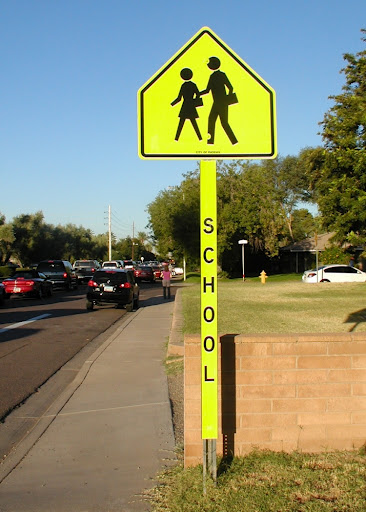Better safe than sorry: Arizona school zones aim to provide safe crossings
Better safe than sorry: Arizona school zones aim to provide safe crossings

The need for pedestrian and bicyclist safety at schools, especially involving young students, cannot be overemphasized. While federal, state and local agencies are encouraging fit and healthy lifestyles by promoting walking and biking to school, the safety of these children should be our highest priority.
Arizona has been a leader in providing a system for safe school crossings, and there is some important information motorists should know while driving around schools in our communities.
Arizona has a unique way to establish low-speed school zone crossings. The system was first established in 1950 through adoption of Arizona Revised Statutes (ARS) 28-797. This state law provides a uniform application of 15 mph school zone traffic control that can only be used for elementary and middle schools (kindergarten through eighth grades) in Arizona at authorized school crossings meeting certain minimum criteria.
Rules of the school zone …
- The 15 mph school zones cannot be used at crosswalks that are controlled by STOP signs or traffic signals.
- The state law provides for the use of portable signs and yellow crosswalk markings, and the 15 mph provision is only in effect when the portable signs are placed in the street.
- The school zone signs are placed and removed by crossing guards or school employees under a special operating agreement between the school district and the traffic agency that controls the roadway, and can only be used for legitimate school crossing activities during a normal school day.
- Each 15 mph school zone is preceded by a permanent fluorescent yellow-green pentagon-shaped advance school warning sign showing two walking school children.
- The first portable sign placed in the street states, “NO PASSING, 15 MPH, FINES DOUBLED, SCHOOL IN SESSION,” which is located about 75 to 300 feet in advance of the yellow crosswalk depending on the non-school posted speed limit. This portable sign is placed at the location where the 15 mph speed limit begins. Furthermore, motorists cannot pass any other slower or stopped vehicles between the first portable 15 mph sign to the yellow crosswalk. At the yellow crosswalk, a different portable sign exists which states, “STOP WHEN CHILDREN IN CROSSWALK.”
A few guidelines …
Unlike white crosswalks where drivers are required to “yield and stop if necessary” to pedestrians crossing on their half of the street, ARS 28-797 requires all drivers to stop if anyone (including children, adults or crossing guards) are present anywhere within the yellow school crosswalk when the portable signs are in the street. After all pedestrians exit the yellow crosswalk, drivers may proceed.
Motorists should be very careful while driving near 15 mph school zone crosswalks, especially when the crossing guards are placing or removing the portable signs from the street. The crossing guards are most vulnerable during these times.
In addition, motorists need to be careful any time while driving in neighborhoods near schools or school crossings, especially during the start and end times of the school day. Motorists also need to be careful around school buses and cannot pass them in either direction if they are displaying their STOP paddle while stopped to pick up or drop off students.
Regardless of the time of the year, motorists should be vigilant while driving in neighborhoods, since young children may dart out from behind a parked car or ride their bike in the street without looking for approaching vehicles. Undoubtedly, it is better to be late for an appointment than to race through a neighborhood and experience a tragic crash with a child.
------------------------------------------------------------------------------
Kohinoor Kar, Ph.D., P.E., PTOE, a professional engineer with 22 years combined experience in the roadway, traffic and safety field, has been with the State of Arizona for past seven years.
Michael J. Cynecki, P.E. recently retired from the City of Phoenix after a career of 26 years in the Transportation Department, and is currently with the consulting firm of Lee Engineering, LLC.
Disclaimer: Opinions expressed in this article are those of the authors or references cited herein and may not necessarily represent the views of the agencies they are affiliated with. Information contained in this article are for general awareness only and are not intended to substitute for professional advice to any particular person or case. Some of the information might change over time in which case the current practice would supersede all previous practices.

